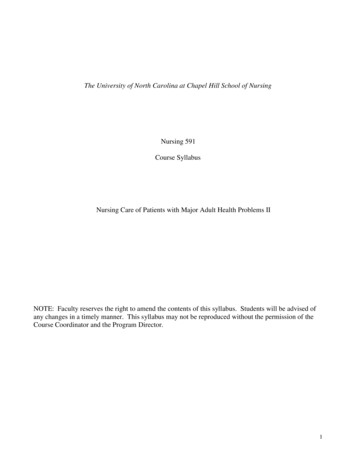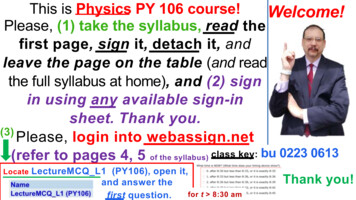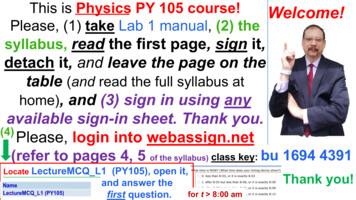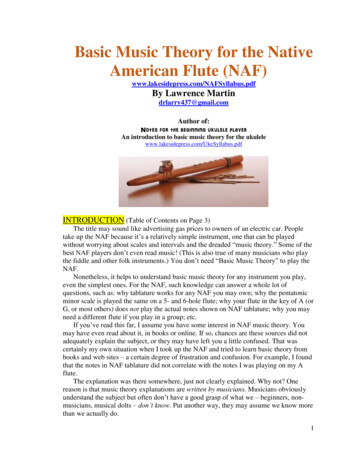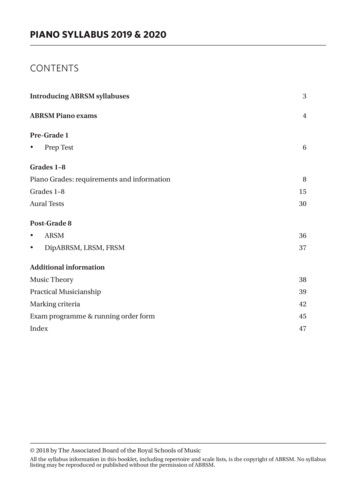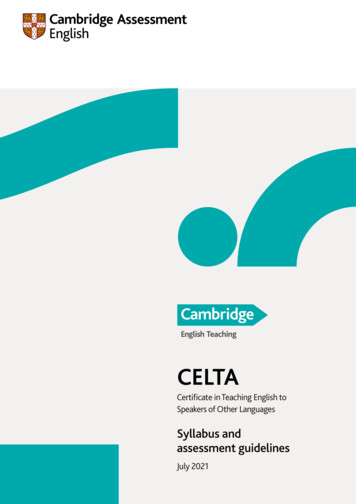
Transcription
CELTACertificate in Teaching English toSpeakers of Other LanguagesSyllabus andassessment guidelinesJuly 2021
ContentsIntroduction2Syllabus overview4Topic descriptions6Topic 1 Learners and teachers, and the teachingand learning context6Topic 2 Language analysis and awareness7Topic 3 Language skills: reading, listening,speaking and writing8Topic 4 Planning and resources for differentteaching contexts10Topic 5 Developing teaching skillsand professionalism11Course requirements and componentsof assessment13Assessment requirements13The two components of assessment13Certificate grades14Component 1: Planning and teaching15Component 2: Classroom-relatedwritten assignments17CELTA (Certificate in Teaching English to Speakers of Other Languages)is regulated by Ofqual (the regulator of qualifications, examinationsand assessments in England) at level 5 on the RegulatedQualifications Framework.
Introduction – Certificate in Teaching English toSpeakers of Other Languages (CELTA)Target candidatureThe Certificate in Teaching English to Speakers of Other Languages (CELTA) is an introductory course for candidates whohave little or no previous English language teaching experience. It may also be suitable for candidates with some experiencebut little previous training.Course aimsThe course enables candidates to: acquire essential subject knowledge and familiarity with the principles of effective teaching acquire a range of practical skills for teaching English to adult learners demonstrate their ability to apply their learning in a real teaching context.Candidates who complete the course successfully can begin working in a variety of English for Speakers of Other Languages(ESOL) teaching contexts around the world.Syllabus overviewThis document outlines the syllabus and assessment criteria for CELTA.The following syllabus is a reflection of the pre-service entry point of prospective candidates and outlines both the subjectknowledge and the pedagogic knowledge and skills required for beginner ESOL teachers.The syllabus consists of five specific topic areas: Topic 1 Learners and teachers, and the teaching and learning context Topic 2 Language analysis and awareness Topic 3 Language skills: reading, listening, speaking and writing Topic 4 Planning and resources for different teaching contexts Topic 5 Developing teaching skills and professionalism.Assessment overviewCELTA is awarded to candidates who have completed the course and who have met the assessment criteria for all writtenand practical assignments.The overall assessment aims for each topic are that candidates should be able to:1. a ssess learner needs, and plan and teach lessons which take account of learners’ backgrounds, learning preferences andcurrent needs2. demonstrate language knowledge and awareness, and appropriate teaching strategies3. demonstrate knowledge about language skills and how they may be acquired4. plan and prepare lessons designed to develop their learners’ overall language competence5. demonstrate an appropriate range of teaching skills at this level and show professional awareness and responsibility.Assessment frameworkThere are two components, Component One: Planning and teaching and Component Two: Classroom-related writtenassignments (of which there are four in total).CELTA is internally assessed and externally moderated by a Cambridge English approved assessor, who samples portfolios andteaching practice, and who discusses and agrees the grades for all candidates.2
Table 1 outlines the relationship of the assessment aims to the assessed work:indicates a main assessment areaindicates a secondary assessment areaTable 1 Assessment gridComponent One:Planning and teachingAimLesson plansTeachingComponent Two:Classroom-related written assignmentsAssignment 1Assignment 2Assignment 3Assignment 412345Table 2 Summary of the primary assessment tasks for each topicTopicsAssessment1. Learners and teachers, and the teaching and learning contextPlanning and teaching – Written assignment 12. Language analysis and awarenessPlanning and teaching – Written assignment 23. Language skills: reading, listening, speaking and writingPlanning and teaching – Written assignment 34. Planning and resources for different teaching contextsPlanning and teaching – Written assignment 45. Developing teaching skills and professionalismPlanning and teaching – Written assignment 5Cambridge English reserves the right to request samples of any work during and up to six months after the course.Course programmesCertificate course programmes are designed by individual centres using the syllabus and course objectives. Courses will havea minimum of 120 contact hours including: input supervised lesson planning teaching practice (six assessed hours) feedback on teaching peer observation observation of experienced teachers (minimum six hours) consultation time.Candidates will need to dedicate a minimum of 80 hours for the required reading, research, pre- and post-session tasks,assignments and lesson preparation.3
Syllabus overviewWhen ‘classroom’ is referred to throughout, it may relate to the physical or online classroom.Topic 1 – Learners and teachers, and the teaching and learning context1.1Cultural, linguistic and educational backgrounds1.2Motivations for learning English as an adult1.3Learning and teaching preferences1.4Context for learning and teaching English1.5Varieties of English1.6Multilingualism and the role of first languagesTopic 2 – Language analysis and awareness2.1Basic concepts and terminology used in ELT to discuss language form and use2.2Grammar: grammatical frameworks: rules and conventions relating to words, sentences, paragraphs and texts2.3Lexis: word formation, meaning and use in context2.4Phonology: the formation and description of English phonemes; features of connected speech2.5The practical significance of similarities and differences between languages2.6Reference materials for language awareness2.7Key strategies and approaches for developing learners’ language knowledgeTopic 3 – Language skills: reading, listening, speaking and writing43.1Reading3.1.1Basic concepts and terminology used for describing reading skills3.1.2Purposes of reading3.1.3Decoding meaning3.1.4Potential barriers to reading3.2Listening3.2.1Basic concepts and terminology used for describing listening skills3.2.2Purposes of listening3.2.3Features of listening texts3.2.4Potential barriers to listening3.3Speaking3.3.1Basic concepts and terminology used for describing speaking skills3.3.2Features of spoken English3.3.3Language functions3.3.4Paralinguistic features3.3.5Phonemic systems3.4Writing3.4.1Basic concepts and terminology used for describing writing skills3.4.2Subskills and features of written texts3.4.3Stages of teaching writing3.4.4Adult literacy3.4.5English spelling and punctuation3.5Teaching3.5.1Key strategies and approaches for developing learners’ receptive and productive skills
Topic 4 – Planning and resources for different teaching contexts4.1Principles of planning for effective teaching of adult learners of English4.2Lesson planning for effective teaching of adult learners of English4.3Evaluation of lesson planning4.4 The selection, adaptation and evaluation of materials and resources in planning (including computer and othertechnology-based resources)4.5 Knowledge of commercially produced resources and non-published materials and classroom resources for teaching Englishto adultsTopic 5 – Developing teaching skills and professionalism5.1The effective organisation of the classroom5.2Classroom presence and control5.3Teacher and learner language5.4The use of teaching materials and resources5.5Practical skills for teaching at a range of levels5.6The monitoring and evaluation of learning5.7Evaluation of the teaching/learning process5.8Professional development: responsibilities5.9Professional development: support systems5
Topic descriptionsTopic 1 – Learners and teachers, and the teaching and learning contextRefSyllabus contentLearning outcomesAssessmentSuccessful candidates are able to:1.1Cultural, linguistic andeducational backgroundsunderstand the range of backgrounds and experiences that adultlearners bring to their classes1.2Motivations for learningEnglish as an adulta. understand the different motivations and expectations thatadults bring to learning Englishb. identify ways in which personal factors may affectlanguage learningc. make practical use of this knowledge and understandingto plan and teach with sensitivityd. develop and maintain motivation, identify and respondto expectations1.3Learning and teachingpreferencesa. demonstrate an awareness of the different learning preferencesthat adults bring to learning Englishb. demonstrate an awareness of the different roles teachers mayadopt at different stages of teaching and in different teaching/learning contextsc. make practical use of this awareness in planning and teaching1.4Context for learning andteaching Englisha. understand in broad terms the context in which teaching istaking place with special reference to the learners, thephysical or online environment and the availability of resourcesb. understand the broad range of learning needsincluding the needs of learners with learning difficultiesand/or disabilitiesc. make practical use of this understanding in adapting teachingto contexts and learners’ needs1.5Varieties of Englisha. understand the main ways that varieties of English differ fromone anotherb. demonstrate awareness of the need for teachers and learnersto make informed choices about language models for teachingand learningc. make practical use of this knowledge and awareness inplanning and teaching1.6Multilingualism and therole of first languagesunderstand the kinds of language backgrounds that learners maycome from (e.g. multilingual/monolingual; standard/non-standard)and how a learner’s language background might influence thelearning of English.Topic 1 assessmentKey assignmentSee Focus on the learner on page 17.Key teaching practice criteriaSee page 15 for criterion 4a and criteria 1a–c.6Teaching practice:Planning and teachingAssignment:Focus on the learner
Topic 2 – Language analysis and awarenessRefSyllabus contentLearning outcomesAssessmentSuccessful candidates are able to:2.12.2Basic concepts andterminology used in ELTto discuss language formand useunderstand key terminology used in ELT to talk about language andapply this terminology to planning and teachingGrammara. understand a range of the rules and conventions relating towords, sentences, paragraphs and textsGrammatical frameworks:rules and conventionsrelating towords, sentences,paragraphs and texts2.3LexisWord formation, meaningand use in contextAssignment:Language related tasksLanguage analysisfor teachingb. demonstrate a basic working knowledge of how the verbphrase and the noun phrase are formed and used in English,for example: tense and aspect voice modality, including the expression of hypothetical meaning finite and non-finite forms the adverbial element countabilitya. understand basic principles of word formation and lexicalmeaning, for example: meaning and definition pronunciation spelling affixation and compounding synonymy and hyponymyb. understand the effect on word choice of factors such as: co-text (e.g. collocation) context of situation (style)2.4Phonologya. demonstrate a working knowledge of the sounds of EnglishThe formation anddescription of Englishphonemesb. understand some features of connected speech, for example: linking assimilation and elision word and sentence stress intonation patternsFeatures of connectedspeech2.5The practical significance ofsimilarities and differencesbetween languagesidentify some significant differences between their own languageand a foreign language, and demonstrate in practice theirunderstanding of the relevance of some of these differences for theteacher and learnerAssignment:Focus onthe learner2.6Reference materials forlanguage awarenessuse a range of reference material to analyse and describe languagefor teaching purposesAssignment:Language related tasks2.7Key strategies andapproaches for developinglearners’ languageknowledgeuse strategies, approaches and techniques to develop learners’language knowledge, for example inductive and deductivepresentations.Teaching practiceTopic 2 assessmentKey assignmentSee Language related tasks on page 17.Key teaching practice criteriaSee pages 15 and 16 for criteria 4a–c, 4i–k and 2a–g.7
Topic 3 – Language skills: reading, listening, speaking and writingRefSyllabus contentLearning outcomesAssessmentSuccessful candidates are able to:3.1Reading3.1.1Basic concepts andterminology used fordescribing reading skillsunderstand basic concepts and terminology used for describingreading skills, and apply this to planning and teaching3.1.2Purposes of readingunderstand how approaches to reading texts vary dependingon the purpose of reading, and make practical use of thisin teaching3.1.3Decoding meaningidentify some of the features which help learners decodemeanings of words, sentences and whole texts, and makepractical use of this in teaching3.1.4Potential barriers to readinga. identify some of the difficulties learners may face whentrying to understand textsTeaching practice:Planning and teachinglessons to developreading skillsAssignment:Language skillsrelated tasksb. identify ways of making reading texts more intelligibleto learners3.2Listening3.2.1Basic concepts andterminology used fordescribing listening skillsunderstand basic concepts and terminology used for describinglistening skills, and apply this to practical teaching3.2.2Purposes of listeningunderstand how approaches to listening texts varydepending on the purpose of listening, and make practical useof this in teaching3.2.3Features of listening textsa. identify some of the features which indicate the purpose ofutterances and listening texts, and which help convey meaningTeaching practice:Planning and teachinglessons to developlistening skillsAssignment:Language skillsrelated tasksb. make practical use of this knowledge and awareness inteaching3.2.4Potential barriers tolisteninga. identify some of the difficulties learners face when listeningb. demonstrate ways of helping learners understand listeningtexts and improve their listening skills3.3Speaking3.3.1Basic concepts andterminology used fordescribing speaking skillsunderstand basic concepts and terminology used for describingspeaking skills, and apply this to practical teaching3.3.2Features of spoken Englisha. identify some key features of spoken Englishb. identify some ways in which spoken English differs fromwritten Englishc. make practical use of this knowledge and awareness inplanning and teaching3.3.3Language functionsa. identify a wide range of language functions and the formsused to express themb. apply knowledge of language functions to planningand teaching83.3.4Paralinguistic featuresunderstand the role of paralinguistic features (e.g. gesture, gaze)in communication3.3.5Phonemic systemsidentify and describe some differences in phonemic systems oflanguages spoken by learnersTeaching practice:Planning and teachinglessons to developspeaking skillsAssignments:Language skillsrelated tasksFocus on the learner
RefSyllabus contentLearning outcomesAssessmentSuccessful candidates are able to:3.4Writing3.4.1Basic concepts andterminology used fordescribing writing skillsunderstand basic concepts and terminology used for describingwriting skills, and apply this to practical teaching3.4.2Subskills and features ofwritten textsa. identify some of the subskills of writingStages of teaching writinga. identify the stages of producing written text3.4.3b. identify some features of written textsTeaching practice:Planning and teachinglessons/parts of lessonsto develop writing skillsAssignment:Focus on the learnerb. make practical use of knowledge about writing subskills,features of written language and stages of producing writtentext in planning and teaching3.4.4Adult literacya. understand some issues relating to adult literacy and use ofnon-Roman scriptb. apply awareness of adult literacy issues to practicalteaching situations3.4.5English spelling andpunctuationa. identify some English spelling patterns and some strategiesto help learners develop their spelling skillsb. identify some ways in which punctuation contributes tomeaning in written textc. apply a basic understanding of English spelling andpunctuation to practical teaching3.5Teaching3.5.1Key strategies andapproaches for developinglearners’ receptive andproductive skillsuse strategies, approaches and techniques to develop learners’receptive and productive skills.Teaching practiceTopic 3 assessmentKey assignmentSee Language skills related tasks on page 17.Key teaching practice criteriaSee pages 15 and 16 for criteria 4a–c, 4l, and 3a–b.9
Topic 4 – Planning and resources for different teaching contextsRefSyllabus contentLearning outcomesAssessmentSuccessful candidates are able to:4.14.2Principles of planning foreffective teaching of adultlearners of Englisha. understand the purpose and principles of planning foreffective teaching of adult learnersLesson planningb. distinguish between different kinds of teaching and differentkinds of lessons, and select the kinds of lessons that are mostappropriate for particular learnersAssignment:Lessons from theclassroomLesson planning for effective a. plan logically sequenced lessons that are appropriate to theteaching of adult learnersneeds of the learnersof Englishb. devise lesson plans which include: a statement of aimsa class profile anticipation of difficulties and suggested solutionsdescription of teacher and learner interactionsdetails of resources to be usedstaged description of procedures includinganticipated timingsc. relate, where appropriate, the learners’ language needs tolearning in other areas, showing awareness of the broadereducational context in which the teaching/learning ofEnglish is situated4.3Evaluation of lessonplanninga. evaluate their own lesson preparation before and afterteaching through reflection and by taking note of commentsfrom tutors, colleagues and learnersb. take account of this evaluation in planning future lessons4.44.5The selection, adaptationand evaluation of materialsand resources in planning(including computer andother technology-basedresources)a. select and evaluate materials and resources (including useof technology and digital tools etc.)Knowledge of commerciallyproduced resources andnon-published materialsand classroom resources forteaching English to adultsdevelop a basic working knowledge of some commerciallyproduced and non-published materials and classroom resourcesfor teaching English to adults.b. understand the need for and begin to put into practice, withdue regard for the provisions of copyright, the adaptation ofresources and materials to meet the requirements of specificgroups of adult learnersTopic 4 assessmentKey assignmentSee Lessons from the classroom on page 18.Key teaching practice criteriaSee page 15 for criteria 4a–n.10Teaching practice
Topic 5 – Developing teaching skills and professionalismRefSyllabus contentLearning outcomesAssessmentSuccessful candidates are able to:5.1The effective organisationof the classrooma. arrange the classroom to suit the learners and the type oflesson, and ensure safety regulations are taken into accountb. set up and manage whole-class work, pair and group work,and individual work as appropriate5.2Classroom presenceand controlestablish and maintain a good rapport with learners at all timesand foster a constructive learning atmosphere5.3Teacher and learnerlanguagea. use their own English language skills and L1 whereappropriate to enhance the effectiveness of their teachingTeaching practiceAssignment:Lessons from theclassroomb. adjust their own use of language to the level of the classc. give clear instructionsd. choose appropriate moments, and appropriate strategies forcorrecting learners’ language5.4The use of teachingmaterials and resourcesa. make appropriate use of a range of materials and resources,including digital, in relation to specified aimsb. understand the implications of teaching with limited resources5.5Practical skills for teachingat a range of levelsa. work successfully with learners at different levels, usingappropriate types of classroom activity to develop learners’language and skillsb. involve learners of different ability levels in the work of theclass and enable them to feel a sense of progress5.6The monitoring andevaluation of learninga. monitor learner behaviours in class time and respondappropriatelyb. incorporate into their lessons some basic assessmentproceduresc. make planning decisions on the basis of assessment5.7Evaluation of the teaching/learning processa. make balanced and constructive self-appraisal of theirown teachingb. respond appropriately to feedback from tutors, peersand learnersc. assess their own strengths and development needs, makepractical use of that assessment and set goals and targetsfor future developmentd. make constructive appraisals of the lessons of their colleagues11
RefSyllabus contentLearning outcomesAssessmentSuccessful candidates are able to:5.8Professional development:responsibilitiesa. demonstrate professional responsibility by followingany institutional code(s) of practice and implementinginstitutional requirements including: health and safety procedures equal opportunities policies record-keeping and time-keeping requirementsb. understand the limits of their responsibility with regard tothe welfare, health, safety and supervision of learners andknow when to assume responsibility themselves or referresponsibility, ensuring that it has been assumed bysomeone else5.9Professional development:support systemsin recognition of the initial nature and scope of their training sofar, respond appropriately to relevant aspects of professionaldevelopment by finding out about opportunities for furtherprofessional development in teaching English to adults, including: appropriate professional associationsmagazinesdigital resourcesjournals and publications for teachers entering the field ofteaching English language to adults.Topic 5 assessmentKey assignmentSee Lessons from the classroom on page 18.Key teaching practice criteriaSee page 16 for criteria 5a–n.12Teaching practiceAssignment:Lessons from theclassroom
Course requirements and componentsof assessmentAssessment requirementsTo meet the assessment requirements, candidates must attend a course and: practice-teach classes of the relevant age group and size for a total of six hours observe experienced teachers teaching classes of language learners for a total of six hours, three of which may be on video maintain and submit a portfolio of all coursework including all written assignments and materials related to teaching practice.Mode of assessmentAssessment is continuous and integrated.Continuous here means that assessment takes place throughout the course.Integrated here means that both assessed components contribute to the overall grade.The two components of assessmentComponent One: Planning and teachingIn this component, candidates are required to practice-teach for a total of six assessed hours, working with adult learnersat a minimum of two levels in classes of the required size. (Please refer to the Administration Handbook for regulationsregarding teaching practice.)By the end of the six hours of assessed teaching practice, candidates should have demonstrated successful achievement of allthe teaching practice assessment criteria, detailed on pages 15–16.Component Two: Classroom-related written assignmentsThis component consists of four written assignments: one assignment focuses on adult learners and learning contexts one assignment focuses on an aspect of the language system of English one assignment focuses on an aspect of language skills one assignment requires reflection on classroom teaching and the identification of action points.The centre is responsible for designing the written assignments, which should each be between 750 and 1,000 words. Theassignments are internally assessed and externally moderated. Two assignments may be conflated into one larger assignmentprovided that all the assessment criteria are met.13
Certificate gradesThe Certificate will be awarded to candidates who meet the course requirements and whose performance meets, orexceeds, the criteria in both assessment components. Candidates are ineligible for the award in cases where dishonesty orplagiarism is brought to the attention of Cambridge English.The following performance descriptors are to be interpreted in the CELTA context, bearing in mind that candidates arepre-service and undertaking initial teacher training including six hours of teaching practice.The CELTA performance descriptors are for use by tutors and assessors at the end of the course to determine finalrecommended grades. By the end of the course, candidates’ performance must match ALL of the descriptors at a particularpassing grade in order to achieve that grade.PassPass BPass APlanningCandidates can plan effectively withguidance. They can analyse targetlanguage adequately and generallyselect appropriate resources and tasksfor successful language and languageskills development.Candidates can plan effectively withsome guidance. They can analysetarget language well and selectappropriate resources and tasks forsuccessful language and languageskills development.Candidates can plan effectively withminimal guidance. They can analysetarget language thoroughly andselect appropriate resources and tasksfor successful language and languageskills development.TeachingCandidates can generally delivereffective language and skills lessons,using a variety of classroom teachingtechniques with a degree of success.Candidates can deliver effectivelanguage and skills lessons, usinga variety of classroom teachingtechniques successfully.Candidates can deliver effectivelanguage and skills lessons, using avariety of classroom teachingtechniques successfully.Candidates show good awarenessof learners and can respond so thatlearners benefit from the lessons.Candidates show very goodawareness of learners and canrespond so that learners benefitfrom the lessons.Awareness Candidates show some awarenessof learners of learners and some ability torespond so that learners benefitfrom the lessons.ReflectionCandidates can reflect on somekey strengths and weaknesses andgenerally use these reflections todevelop their teaching skills.Candidates can reflect on keystrengths and weaknesses andgenerally use these reflections todevelop their teaching skills.Candidates can reflect on keystrengths and weaknesses andconsistently use these reflections todevelop their teaching skills.OverallCandidates’ planning and teachingshow satisfactory understandingof English language learning andteaching processes at CELTA level.Candidates’ planning and teachingshow good understanding of Englishlanguage learning and teachingprocesses at CELTA level.Candidates’ planning and teachingshow excellent understandingof English language learning andteaching processes at CELTA level.All CELTA assessment criteria are achieved and requirements for written work are met.FailCandidates’ performance does not match all of the Pass descriptors.Some CELTA assessment criteria are not achieved and/or requirements for written work are not met.14
Component 1: Planning and teachingCentres are responsible for including six hours’ supervised and assessed teaching practice as part of the programme. Thisteaching practice will typically involve candidates working with specially arranged groups of learners. In some colleges,candidates may be placed as an apprentice with a class teacher and work alongside the class teacher in a supervised role.The teaching practice is timetabled on a continuous basis throughout the course so that opportunities are provided forcandidates to show that they can apply theory to practice in classroom teaching. In their teaching and in their lesson plans,candidates should demonstrate an increasing ability in their achievement of the assessment criteria which are detailed below.By the end of the course, candidates should be able to plan, prepare and teach a range of lessons designed for adult learnersof English.The programme for the six hours’ assessed teaching practice should provide each candidate with opportunities to teach for atleast two hours at two different levels, one of which should be below intermediate level. The number of occasions on whichcandidates should practice-teach and the length of the assessed lessons are not specified, but on a minimum of two occasions,opportunities to practice-teach for at least 40 minutes should be provided. Opportunities for candidates to teach a broad rangeof lesson types should also be included.The overall scope and assessment criteria for teaching practice are described below. Please note that in order to show how theassessment criteria are linked to the syllabus, each criterion is introduced by a number that refers to a corresponding topicof the syllabus.Planning and teachingBy the end of the six hours’ assessed teaching practice, successful candidates at Pass level should show convincingly thatthey can:prepare and plan for the effective teaching of adult ESOL learners by:4aidentifying and stating appropriate aims/outcomes for individual lessons4bordering activities so that they achieve lesson aims/outcomes4cselecting, adapting or designing materials, activities, resources and technical aids appropriate for the lesson4dpresenting the materials for classroom use with a professional appearance, and with regard to copyright requirements4edescribing the procedure of the lesson in sufficient detail4fincluding interaction patterns appropriate for the materials and activi
rules and conventions relating to words, sentences, paragraphs and texts a. understand a range of the rules and conventions relating to words, sentences, paragraphs and texts b. demonstrate a basic working knowledge of how the verb phrase and the noun phrase are formed and used in
